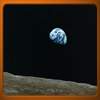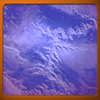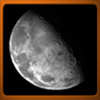You are seeing this message because you are using an out-of-date browser.
Please click here for more information.
There's No Place Like Home
Our home planet is a very interesting place. From space, it looks like a big blue marble, with the constantly changing cloud patterns giving our home planet an ever-changing appearance. There are a number of things that make our planet unique in the solar system, not the least of which is that we are the only planet so far that we know for certain has ever had life of any kind. This may change in the future, but so far we humans are the only life form that we have found.
Among the things that have made life as we know it possible here on Earth are the facts that most of the surface of our planet is covered with water and we are protected from most of the Sun's dangerous radiation by our atmosphere. Our atmosphere, which is the layer of gas surrounding Earth, is made up of about seventy-seven percent nitrogen, which is what the plants breathe, and about twenty-one percent oxygen, which is what we humans breathe.
A Big Blue Marble
If other beings exist, and they are watching our solar system with their telescopes, the view of our home planet must be very interesting, indeed. Because over seventy percent of Earth's surface is covered with water, the predominant color they would see is blue. However, the continents would provide an interesting color show of their own, ranging from the stark white of Antarctica, through the browns of north Africa and on to the mostly greens of Asia and the Americas. At the same time, the oceans and our atmosphere interact with each other to create constantly changing cloud patterns that would resemble a kind of kaleidoscope.
It would present as great a puzzle to them as the gas giants of our own solar system (Jupiter, Saturn, Neptune and Uranus) present to scientists here on Earth.
A Very Large Onion
If you could cut a section out of Earth and look inside, you would see what looks like
a very large onion. Our home planet has many "layers", ranging from a very dense inner
core, made mostly of iron, to the outermost layer, which is the one we live on.
In between the solid central core of our planet and the outer layer that we live on is
what amounts to a vast sea of molten, or semi-melted rock. This molten layer, called "magma"
is very hot and occasionally breaks through, or erupts, to the surface. When this
happens, we have what we have come to know as a volcano. Many features on our planet's
surface, including the Hawaiian islands, are a direct result of this volcanic activity.
After a volcanic eruption occurs, the melted rock, called "lava", that makes it to surface
cools off and eventually changes back into solid rock. If enough eruptions occur at the
same place, the rock that accumulates can form islands in the ocean or mountains on land.
The sea of molten iron that makes up most of Earth is also what makes the surface of our planet a constantly changing place. Scientists believe that hundreds of millions of years ago, all of the land that is here was concentrated into one giant continent instead of the seven we have now. Over a very long period of time, the original giant land mass was broken up into the several continents that we have now. You can see for yourself how this has happened by noticing how the shapes of some of the continents, South America and Africa, for example, seem to fit together like pieces of a giant puzzle. This process continues to this day. As hard as it might be to believe, the continents that we are familiar with are actually drifting around, like crackers on a bowl of soup.
The Fascinating Surface of Earth
The surface of our home planet is the most widely varied surface of any planet n the solar system. The motion of the continents we mentioned before, in combination with the winds of the atmosphere, rain that falls from the clouds in the sky and volcanic eruptions, along with other events, has turned our planet into an almost magical place.
In the western United States, for example, you can go from the desert floor of Death Valley to the peaks of mountains in the space of a few hundred miles. The Hawaiian Islands rise from the floor of the Pacific Ocean to the peak of Diamond Head. All in all, if you want to visit a planet with the most interesting features in the solar system, you need look no further than your own back yard.
The Changing Seasons
If you happen to live very far north or south of the equator, which is the imaginary line
at the middle of our planet, you will notice that the weather goes through four seasons.
Our seasons occur because Earth does not stand straight up on its axis, but instead is
slightly tilted on its north to south axis (the axis is the imaginary line that runs through
the planet, just like the spindle in a toy top). As Earth goes around the Sun during the
year, different parts of the planet are tilted towards the Sun. For example, here in the
Unites States, we have our warmer months during summer because at that time of the year
our part of the planet is tilted towards the Sun. At the same time, people in the southern
hemisphere are experiencing winter because their part of the planet is tilted away from
the Sun. While we have the colder weather during the winter season, residents of the southern
hermisphere are having summer.
Our Only Moon
Earth has only one moon, but it has a large effect on our culture as well as our sky. We are the only planet in the solar system that has total solar eclipses, which is what happens when the Moon completely blocks our view of the Sun. We also have lunar eclipses, which happen when the Moon passes through Earth's shadow. In addition, our Moon goes through "phases" that not only make for interesting viewing in the night sky, but also serve as the basis for the months in our calendar.
Our Moon is the only body in the solar system besides Earth that has had human visitors. During the late 1960's and on into the 1970's men landed on the Moon and explored it a dozen times. The research that was done during and after these missions has told us that the Moon is a fascinating place in its own right.
- Earth Page at the Nine Planets Site
- The Earth section of the Nine Planets site has more detail about our home planet.
- The Landsat Project
- The Landsat project is an excellent source of images of our home planet taken by satellites. You may be able to find your home town, or even your house!
- NASA's Earth Observatory
- The Earth Observatory site has a very impressive collection of images of our home from outer space as well as news about studies of our planet.
- Terraserver
- The Microsoft Terraserver project is trying to become the central place to look for images of Earth on the web. Some of these images are absolutely incredible.
There is an Adobe® Acrobat® file (113k) for Earth. You can view the file online by clicking
here. You can save the file on your computer by right-clicking on the link.
You will need the free
Adobe® Acrobat® ReaderTM
to view the file.





